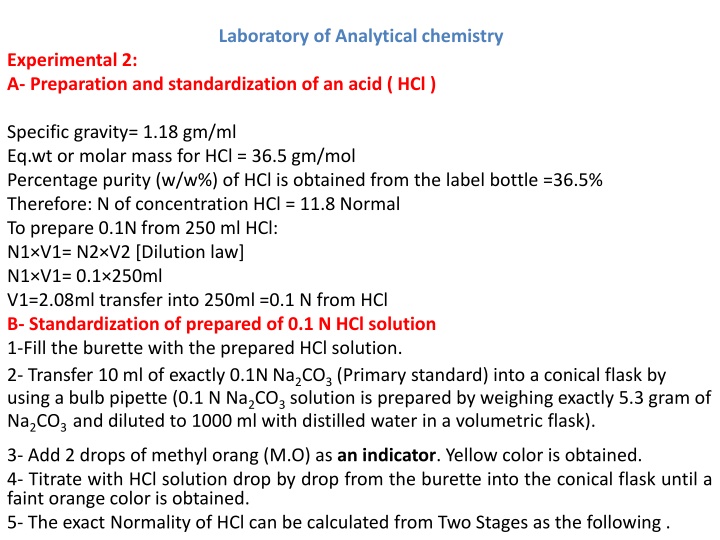
Experimental Procedure for Standardization of HCl Solution in Analytical Chemistry Lab
Learn how to prepare and standardize an HCl solution in the analytical chemistry lab using precise measurements and indicators. Understand the concept of titration, equivalence points, and the role of indicators in the process. Get insights into the chemical reactions involved and the significance of accurate measurements in laboratory experiments.
Download Presentation

Please find below an Image/Link to download the presentation.
The content on the website is provided AS IS for your information and personal use only. It may not be sold, licensed, or shared on other websites without obtaining consent from the author. If you encounter any issues during the download, it is possible that the publisher has removed the file from their server.
You are allowed to download the files provided on this website for personal or commercial use, subject to the condition that they are used lawfully. All files are the property of their respective owners.
The content on the website is provided AS IS for your information and personal use only. It may not be sold, licensed, or shared on other websites without obtaining consent from the author.
E N D
Presentation Transcript
Laboratory of Analytical chemistry Experimental 2: A- Preparation and standardization of an acid ( HCl ) Specific gravity= 1.18 gm/ml Eq.wt or molar mass for HCl = 36.5 gm/mol Percentage purity (w/w%) of HCl is obtained from the label bottle =36.5% Therefore: N of concentration HCl = 11.8 Normal To prepare 0.1N from 250 ml HCl: N1 V1= N2 V2 [Dilution law] N1 V1= 0.1 250ml V1=2.08ml transfer into 250ml =0.1 N from HCl B- Standardization of prepared of 0.1 N HCl solution 1-Fill the burette with the prepared HCl solution. 2- Transfer 10 ml of exactly 0.1N Na2CO3(Primary standard) into a conical flask by using a bulb pipette (0.1 N Na2CO3solution is prepared by weighing exactly 5.3 gram of Na2CO3 and diluted to 1000 ml with distilled water in a volumetric flask). 3- Add 2 drops of methyl orang (M.O) as an indicator. Yellow color is obtained. 4- Titrate with HCl solution drop by drop from the burette into the conical flask until a faint orange color is obtained. 5- The exact Normality of HCl can be calculated from Two Stages as the following .
(1) Na2CO3 + HCl NaCl + NaHCO3 (2) NaHCO3 + HCl NaCl + H2O + CO2 In the equivalence point in the equation (1) the pH equal 8.3 So; we can use phenolphthalein indicator (ph.ph) , but in the step (2) the pH equal 3.8, So does not used ph.ph but another indicator is Methyl Orange(M.O). In this experimental; Methyl orange is used as single, So the Reaction equation between Hydrochloric acid and Sodium Carbonate is as follows: 2HCl + Na2CO3 2NaCl + CO2+ H2O An indicator? Is a chemical compound that exhibits a change in color as a result of concentration changes that occurring near the equivalence point. Characteristics of Suitable indicator: The change in the color of the manual must be clear. 2 - The pH range during which the change in color must be based on the full reaction.
Adding hydrochloric acid to sodium carbonate solution The overall equation for the reaction between sodium carbonate solution and dilute hydrochloric acid is: If you had the two solutions of the same concentration, you would have to use twice the volume of hydrochloric acid to reach the equivalence point - because of the 1 : 2 ratio in the equation. Suppose you start with 25 ml of sodium carbonate solution, and that both solutions have the same concentration of 1 mol dm-3 That means that you would expect the steep drop in the titration curve to come after you had added 50 ml of acid. The actual graph looks like this:
The graph is more complicated than you might think - and curious things happen during the titration. You expect carbonates to produce carbon dioxide when you add acids to them, but in the early stages of this titration, no carbon dioxide is given off at all. Then - as soon as you get past the half-way point in the titration - lots of carbon dioxide is suddenly released. The graph is showing two end points - one at a pH of 8.3 (little more than a point of inflexion), and a second at about pH 3.7. The reaction is obviously happening in two distinct parts. In the first part, complete at A in the diagram, the sodium carbonate is reacting with the acid to produce sodium hydrogencarbonate: You can see that the reaction doesn't produce any carbon dioxide. In the second part, the sodium hydrogen carbonate produced goes on to react with more acid - giving off lots of CO2That reaction is finished at B on the graph. It is possible to pick up both of these end points by careful choice of indicator. That is explained on the separate page on indicators. Lecturer Dr. Hussein N.K. AL-Salman
Specifications of the primary standard material in chemistry: 1-The material must be non-hygroscopic. 2-It must also not be subject to any change during the weighing process. 3-The substance must be easily soluble in water under the conditions in which it is used. 4-Its equivalent weight must be large so that weight errors become negligible.
